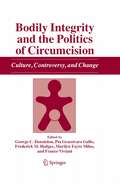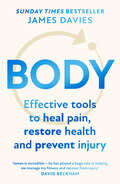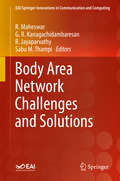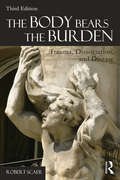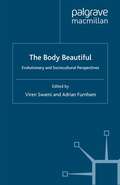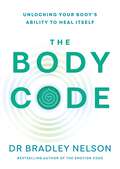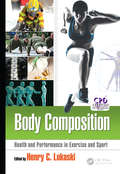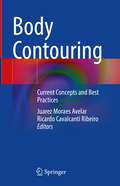- Table View
- List View
Bodily Integrity and the Politics of Circumcision: Culture, Controversy, and Change
by George C. Denniston Pia Grassivaro Gallo Frederick M. Hodges Marilyn Fayre Milos Franco VivianiEvery year 13.3 millions boys and 2 million girls are subjected to circumcision, the involuntary removal of part or all of their external sex organs. Bodily Integrity and the Politics of Circumcision illuminates the vulnerability of human society to medical, economic, and historical pressures. It provides a much-needed, thoughtful, and detailed analysis of the devastating impact of circumcision on bodily integrity and human rights, and it provides hope for change.
Body
by null James DaviesThe Sunday Times bestseller with all the strategies you need to prevent pain and fuel your body to its fullest health potential. ‘James is incredible – he has played a huge role in helping me manage my fitness and recover from injury over the years’ David Beckham Simple techniques and strategies to HEAL From stress and anxiety, to everyday wear and tear and injury, life takes its toll on our bodies. Now, internationally renowned osteopath James Davies can help you heal your body. RESET With tips and tricks to help recognise, manage, and treat everyday aches and pains, this book will reset your approach to understanding your body. James presents a revolutionary blueprint for holistic body wellbeing. RESTORE Improve your wellbeing with exercises expertly designed to optimise your body. Enhance your health and mobility by understanding common conditions from arthritis and muscle strains, to IBS and stress, and empower yourself with the knowledge you need to achieve full-body health. BODY was number 9 in the Sunday Times Bestseller Chart w/b 12th September 2022
Body and City: Histories of Urban Public Health (Historical Urban Studies Series)
by Sally Sheard Helen PowerA provocative survey of new research in the history of urban public health, Body and City links the approaches of demographic and medical history with the methodologies of urban history and historical geography. It challenges older methodologies, offering new insights into the significance of cultural history, which has largely been overlooked by previous histories of public health. This book explores important issues and experiences in the public health arena in diverse European settings from the Middle Ages to the early 20th century.
Body and City: Histories of Urban Public Health (Historical Urban Studies Series)
by Sally Sheard Helen PowerA provocative survey of new research in the history of urban public health, Body and City links the approaches of demographic and medical history with the methodologies of urban history and historical geography. It challenges older methodologies, offering new insights into the significance of cultural history, which has largely been overlooked by previous histories of public health. This book explores important issues and experiences in the public health arena in diverse European settings from the Middle Ages to the early 20th century.
Body Area Network Challenges and Solutions (EAI/Springer Innovations in Communication and Computing)
by R. Maheswar G. R. Kanagachidambaresan R. Jayaparvathy Sabu M. ThampiThis book provides a novel solution for existing challenges in wireless body sensor networks (WBAN) such as network lifetime, fault tolerant approaches, reliability, security, and privacy. The contributors first discuss emerging trends of WBAN in the present health care system. They then provide possible solutions to challenges inherent in WBANs. Finally, they discuss results in working environments. Topics include communication protocols of implanted, wearable and nano body sensor networks; energy harvesting methodologies and experimentation for WBAN; reliability analysis and fault tolerant architecture for WBAN; and handling network failure during critical duration. The contributors consist of researchers and practitioners in WBAN around the world.
Body Area Networks. Smart IoT and Big Data for Intelligent Health: 15th EAI International Conference, BODYNETS 2020, Tallinn, Estonia, October 21, 2020, Proceedings (Lecture Notes of the Institute for Computer Sciences, Social Informatics and Telecommunications Engineering #330)
by Muhammad Mahtab Alam Matti Hämäläinen Lorenzo Mucchi Imran Khan Niazi Yannick Le MoullecThis book constitutes the refereed post-conference proceedings of the 15th International Conference on Body Area Networks, BodyNets 2020, held in Tallinn, Estonia, in October 2020. The conference was held virtually due to the COVID-19 pandemic.The 15 papers presented were selected from 30 submissions and issue new technologies to provide trustable measuring and communications mechanisms from the data source to medical health databases. Wireless body area networks (WBAN) are one major element in this process. Not only on-body devices but also technologies providing information from inside a body are in the focus of this conference. Dependable communications combined with accurate localization and behavior analysis will benefit WBAN technology and make the healthcare processes more effective.
Body Area Networks: 14th EAI International Conference, BODYNETS 2019, Florence, Italy, October 2-3, 2019, Proceedings (Lecture Notes of the Institute for Computer Sciences, Social Informatics and Telecommunications Engineering #297)
by Lorenzo Mucchi Matti Hämäläinen Sara Jayousi Simone MorosiThis book constitutes the refereed post-conference proceedings of the 14th EAI International Conference on Body Area Networks, BodyNets 2019, held in Florence, Italy, in October 2019. The 27 papers presented were selected from 54 submissions and issue new technologies to provide trustable measuring and communications mechanisms from the data source to medical health databases. Wireless body area networks (WBAN) are one major element in this process. Not only on-body devices but also technologies providing information from inside a body are in the focus of this conference. Dependable communications combined with accurate localization and behavior analysis will benefit WBAN technology and make the healthcare processes more effective.
Body Area Networks. Smart IoT and Big Data for Intelligent Health Management: 16th EAI International Conference, BODYNETS 2021, Virtual Event, October 25-26, 2021, Proceedings (Lecture Notes of the Institute for Computer Sciences, Social Informatics and Telecommunications Engineering #420)
by Masood Ur Rehman Ahmed ZohaThis book constitutes the refereed post-conference proceedings of the 16th International Conference on Body Area Networks, BodyNets 2021, held in October 2021. The conference was held virtually due to the COVID-19 pandemic. The 21 papers presented were selected from 44 submissions and issue new technologies to provide trustable measuring and communications mechanisms from the data source to medical health databases. Wireless body area networks (WBAN) are one major element in this process. Not only on-body devices but also technologies providing information from inside a body are in the focus of this conference. Dependable communications combined with accurate localization and behavior analysis will benefit WBAN technology and make the healthcare processes more effective.
Body Art (Arts for Health)
by Brian Brown Virginia Kuulei BerndtBody art, especially tattoos and piercings, has enjoyed an explosion of interest in recent years. However, the response of many health professionals and researchers to this phenomenon is often negative, as body art continues to be associated with issues ranging from ill mental health to offending behaviors. Arguing for a reappraisal of the diverse range of practices that fall under this heading, Brian Brown and Virginia Kuulei Berndt reconsider body art as an underappreciated yet accessible source for mental and physical wellbeing. How, they ask, does body art open up new sources of community, sociality, and aesthetics? How is it used for the reclamation of one’s body, as a marker of success or accomplishment, or for building friendships? How does participation in these practices impact the health and wellbeing of body artists themselves? Providing a radical rethink that integrates tattoos and other body modifications within health, wellbeing, and positive psychology, Body Art disrupts the narrative of stigmatisation that so often surrounds these practices to welcome a broader discussion of the benefits they can offer.
Body Art (Arts for Health)
by Brian Brown Virginia Kuulei BerndtBody art, especially tattoos and piercings, has enjoyed an explosion of interest in recent years. However, the response of many health professionals and researchers to this phenomenon is often negative, as body art continues to be associated with issues ranging from ill mental health to offending behaviors. Arguing for a reappraisal of the diverse range of practices that fall under this heading, Brian Brown and Virginia Kuulei Berndt reconsider body art as an underappreciated yet accessible source for mental and physical wellbeing. How, they ask, does body art open up new sources of community, sociality, and aesthetics? How is it used for the reclamation of one’s body, as a marker of success or accomplishment, or for building friendships? How does participation in these practices impact the health and wellbeing of body artists themselves? Providing a radical rethink that integrates tattoos and other body modifications within health, wellbeing, and positive psychology, Body Art disrupts the narrative of stigmatisation that so often surrounds these practices to welcome a broader discussion of the benefits they can offer.
The Body Bears the Burden: Trauma, Dissociation, and Disease
by Robert ScaerWhen The Body Bears the Burden made its debut in 2001, it changed the way people thought about trauma, PTSD, and the treatment of chronic stress disorders. Now in its third edition, this revered text offers a fully updated and revised analysis of the relationship between mind, body, and the processing of trauma. Here, clinicians will find detailed, thorough explorations of some of neurobiology’s fundamental tenets, the connections between mind, brain, and body, and the many and varied ways that symptoms of traumatic stress become visible to those who know to look for them.
The Body Bears the Burden: Trauma, Dissociation, and Disease
by Robert ScaerWhen The Body Bears the Burden made its debut in 2001, it changed the way people thought about trauma, PTSD, and the treatment of chronic stress disorders. Now in its third edition, this revered text offers a fully updated and revised analysis of the relationship between mind, body, and the processing of trauma. Here, clinicians will find detailed, thorough explorations of some of neurobiology’s fundamental tenets, the connections between mind, brain, and body, and the many and varied ways that symptoms of traumatic stress become visible to those who know to look for them.
The Body Beautiful: Evolutionary and Sociocultural Perspectives
by V. Swami A. FurnhamIn this volume, contributors from a range of perspectives - evolutionary psychology to anthropology, sociology to cognitive and motivational psychology - explore questions of what our attractiveness preferences are and why we find certain others physically attractive, offering a fresh perspective to understanding the perception of attractiveness.
Body by Darwin: How Evolution Shapes Our Health and Transforms Medicine
by Jeremy TaylorWe think of medical science and doctors as focused on treating conditions—whether it’s a cough or an aching back. But the sicknesses and complaints that cause us to seek medical attention actually have deeper origins than the superficial germs and behaviors we regularly fault. In fact, as Jeremy Taylor shows in Body by Darwin, we can trace the roots of many medical conditions through our evolutionary history, revealing what has made us susceptible to certain illnesses and ailments over time and how we can use that knowledge to help us treat or prevent problems in the future. In Body by Darwin, Taylor examines the evolutionary origins of some of our most common and serious health issues. To begin, he looks at the hygiene hypothesis, which argues that our obsession with anti-bacterial cleanliness, particularly at a young age, may be making us more vulnerable to autoimmune and allergic diseases. He also discusses diseases of the eye, the medical consequences of bipedalism as they relate to all those aches and pains in our backs and knees, the rise of Alzheimer’s disease, and how cancers become so malignant that they kill us despite the toxic chemotherapy we throw at them. Taylor explains why it helps to think about heart disease in relation to the demands of an ever-growing, dense, muscular pump that requires increasing amounts of nutrients, and he discusses how walking upright and giving birth to ever larger babies led to a problematic compromise in the design of the female spine and pelvis. Throughout, he not only explores the impact of evolution on human form and function, but he integrates science with stories from actual patients and doctors, closely examining the implications for our health. As Taylor shows, evolutionary medicine allows us think about the human body and its adaptations in a completely new and productive way. By exploring how our body’s performance is shaped by its past, Body by Darwin draws powerful connections between our ancient human history and the future of potential medical advances that can harness this knowledge.
Body by Darwin: How Evolution Shapes Our Health and Transforms Medicine
by Jeremy TaylorWe think of medical science and doctors as focused on treating conditions—whether it’s a cough or an aching back. But the sicknesses and complaints that cause us to seek medical attention actually have deeper origins than the superficial germs and behaviors we regularly fault. In fact, as Jeremy Taylor shows in Body by Darwin, we can trace the roots of many medical conditions through our evolutionary history, revealing what has made us susceptible to certain illnesses and ailments over time and how we can use that knowledge to help us treat or prevent problems in the future. In Body by Darwin, Taylor examines the evolutionary origins of some of our most common and serious health issues. To begin, he looks at the hygiene hypothesis, which argues that our obsession with anti-bacterial cleanliness, particularly at a young age, may be making us more vulnerable to autoimmune and allergic diseases. He also discusses diseases of the eye, the medical consequences of bipedalism as they relate to all those aches and pains in our backs and knees, the rise of Alzheimer’s disease, and how cancers become so malignant that they kill us despite the toxic chemotherapy we throw at them. Taylor explains why it helps to think about heart disease in relation to the demands of an ever-growing, dense, muscular pump that requires increasing amounts of nutrients, and he discusses how walking upright and giving birth to ever larger babies led to a problematic compromise in the design of the female spine and pelvis. Throughout, he not only explores the impact of evolution on human form and function, but he integrates science with stories from actual patients and doctors, closely examining the implications for our health. As Taylor shows, evolutionary medicine allows us think about the human body and its adaptations in a completely new and productive way. By exploring how our body’s performance is shaped by its past, Body by Darwin draws powerful connections between our ancient human history and the future of potential medical advances that can harness this knowledge.
Body by Darwin: How Evolution Shapes Our Health and Transforms Medicine
by Jeremy TaylorWe think of medical science and doctors as focused on treating conditions—whether it’s a cough or an aching back. But the sicknesses and complaints that cause us to seek medical attention actually have deeper origins than the superficial germs and behaviors we regularly fault. In fact, as Jeremy Taylor shows in Body by Darwin, we can trace the roots of many medical conditions through our evolutionary history, revealing what has made us susceptible to certain illnesses and ailments over time and how we can use that knowledge to help us treat or prevent problems in the future. In Body by Darwin, Taylor examines the evolutionary origins of some of our most common and serious health issues. To begin, he looks at the hygiene hypothesis, which argues that our obsession with anti-bacterial cleanliness, particularly at a young age, may be making us more vulnerable to autoimmune and allergic diseases. He also discusses diseases of the eye, the medical consequences of bipedalism as they relate to all those aches and pains in our backs and knees, the rise of Alzheimer’s disease, and how cancers become so malignant that they kill us despite the toxic chemotherapy we throw at them. Taylor explains why it helps to think about heart disease in relation to the demands of an ever-growing, dense, muscular pump that requires increasing amounts of nutrients, and he discusses how walking upright and giving birth to ever larger babies led to a problematic compromise in the design of the female spine and pelvis. Throughout, he not only explores the impact of evolution on human form and function, but he integrates science with stories from actual patients and doctors, closely examining the implications for our health. As Taylor shows, evolutionary medicine allows us think about the human body and its adaptations in a completely new and productive way. By exploring how our body’s performance is shaped by its past, Body by Darwin draws powerful connections between our ancient human history and the future of potential medical advances that can harness this knowledge.
Body by Darwin: How Evolution Shapes Our Health and Transforms Medicine
by Jeremy TaylorWe think of medical science and doctors as focused on treating conditions—whether it’s a cough or an aching back. But the sicknesses and complaints that cause us to seek medical attention actually have deeper origins than the superficial germs and behaviors we regularly fault. In fact, as Jeremy Taylor shows in Body by Darwin, we can trace the roots of many medical conditions through our evolutionary history, revealing what has made us susceptible to certain illnesses and ailments over time and how we can use that knowledge to help us treat or prevent problems in the future. In Body by Darwin, Taylor examines the evolutionary origins of some of our most common and serious health issues. To begin, he looks at the hygiene hypothesis, which argues that our obsession with anti-bacterial cleanliness, particularly at a young age, may be making us more vulnerable to autoimmune and allergic diseases. He also discusses diseases of the eye, the medical consequences of bipedalism as they relate to all those aches and pains in our backs and knees, the rise of Alzheimer’s disease, and how cancers become so malignant that they kill us despite the toxic chemotherapy we throw at them. Taylor explains why it helps to think about heart disease in relation to the demands of an ever-growing, dense, muscular pump that requires increasing amounts of nutrients, and he discusses how walking upright and giving birth to ever larger babies led to a problematic compromise in the design of the female spine and pelvis. Throughout, he not only explores the impact of evolution on human form and function, but he integrates science with stories from actual patients and doctors, closely examining the implications for our health. As Taylor shows, evolutionary medicine allows us think about the human body and its adaptations in a completely new and productive way. By exploring how our body’s performance is shaped by its past, Body by Darwin draws powerful connections between our ancient human history and the future of potential medical advances that can harness this knowledge.
The Body Code: Unlocking your body’s ability to heal itself
by Dr Bradley NelsonHeal yourself in body and mind The Body Code is a truly revolutionary method of holistic healing. Dr. Bradley Nelson, a globally renowned expert in bioenergetic medicine, has spent decades teaching his powerful self-healing method and training practitioners around the globe, but this is the first time his system of healing will be available to the general public in the form of The Body Code.The Body Code is based on the simple premise that the body is self-healing and knows what it needs in order to thrive and flourish. The Body Code method allows readers to tap into this inner knowing, and find imbalances in 6 key areas - Energies, Circuits and Systems, Toxicity, Nutrition and Lifestyle, Misalignments, and Pathogens - that are the root causes of our physical, mental and emotional issues. By identifying and releasing these imbalances, readers become empowered to activate their body's innate healing power.Filled with powerful first-hand accounts of healing, hundreds of colour illustrations, and concrete, actionable steps, The Body Code is a road map to healing based in deep study of the human body, time-proven ancient practices, and the unlimited power of the subconscious mind.
Body Composition: Health and Performance in Exercise and Sport
by Henry C. LukaskiInterest in the relationships between body structure and function in physical activity has persisted for centuries. Body Composition: Health and Performance in Exercise and Sport advances understanding beyond simple descriptions of body physique and composition of athletes and fills gaps in our understanding of the important role of muscle, fat, and bone in facilitating physical performance and health in sports and physically demanding occupations. lt addresses basic, practical, and applied topics in body composition, performance, and health with comprehensive reviews organized in four logical parts: Body Composition Assessment; Physical Activity and Body Composition; Body Composition in Sports and Occupations; and Moderating Factors. This book integrates state-of-the-art knowledge by international experts in the field and produces an evidence-based practical guide for a balanced understanding of the role and use of body composition assessment in physical performance and health for youth and adults. It also provides a needed link between the practice of body composition assessment and its application by members of public health advisory committees that develop national guidelines for diet, physical activity, and health. This book is suitable for students and professionals in sports nutrition, exercise science, kinesiology, and athletic training. Sport administrators and policy-makers for international and national sport federations and organizations, and national intercollegiate and scholastic federations, would also benefit from this book.
Body Composition: Health and Performance in Exercise and Sport
by Henry C. LukaskiInterest in the relationships between body structure and function in physical activity has persisted for centuries. Body Composition: Health and Performance in Exercise and Sport advances understanding beyond simple descriptions of body physique and composition of athletes and fills gaps in our understanding of the important role of muscle, fat, and bone in facilitating physical performance and health in sports and physically demanding occupations. lt addresses basic, practical, and applied topics in body composition, performance, and health with comprehensive reviews organized in four logical parts: Body Composition Assessment; Physical Activity and Body Composition; Body Composition in Sports and Occupations; and Moderating Factors. This book integrates state-of-the-art knowledge by international experts in the field and produces an evidence-based practical guide for a balanced understanding of the role and use of body composition assessment in physical performance and health for youth and adults. It also provides a needed link between the practice of body composition assessment and its application by members of public health advisory committees that develop national guidelines for diet, physical activity, and health. This book is suitable for students and professionals in sports nutrition, exercise science, kinesiology, and athletic training. Sport administrators and policy-makers for international and national sport federations and organizations, and national intercollegiate and scholastic federations, would also benefit from this book.
Body Composition in Sport, Exercise and Health
by Arthur D. Stewart Laura SuttonThe analysis of body composition (fat, bone and muscle) is an important process throughout the biomedical sciences. This is the first book to offer a clear and detailed introduction to the key methods and techniques in body composition analysis and to explain the importance of body composition data in the context of sport, exercise and health. With contributions from some of the world’s leading body composition specialists, the book goes further than any other in demonstrating the practical and applied value of body composition analysis in areas such as performance sport and weight control in clinical populations. The book pays particular attention to the important concept of change in body composition, and includes discussion of ethical issues in the collection, interpretation and presentation of data, and considerations when working with special populations. Bridging the gap between research methods and practical application, this book is important reading for advanced students and practitioners working in sport and exercise science, health science, anatomy, nutrition, physical therapy or ergonomics.
Body Composition in Sport, Exercise and Health
by D. Stewart Laura SuttonThe analysis of body composition (fat, bone and muscle) is an important process throughout the biomedical sciences. This is the first book to offer a clear and detailed introduction to the key methods and techniques in body composition analysis and to explain the importance of body composition data in the context of sport, exercise and health. With contributions from some of the world’s leading body composition specialists, the book goes further than any other in demonstrating the practical and applied value of body composition analysis in areas such as performance sport and weight control in clinical populations. The book pays particular attention to the important concept of change in body composition, and includes discussion of ethical issues in the collection, interpretation and presentation of data, and considerations when working with special populations. Bridging the gap between research methods and practical application, this book is important reading for advanced students and practitioners working in sport and exercise science, health science, anatomy, nutrition, physical therapy or ergonomics.
Body Contouring: Current Concepts and Best Practices
by Juarez Moraes Avelar Ricardo Cavalcanti RibeiroBody contouring surgeries are pretty common among plastic surgeons and the Brazilian Plastic Surgery is one of the most recognized in terms of innovations. This book proposes a new approach for treatment of all body abnormalities in order to achieve aesthetic improvement. Written by Brazilian expert contributors, it addresses all body segments related to body contouring, such as breast, abdomen, dorsum, buttocks, lower and upper limbs, and also body lifting techniques after large weight loss. Associated surgeries, new invasive and non-invasive techniques and technologies such as: robotics, lasers, ultrasound, among others will be carefully described in 59 chapters. The work will also discuss the behavior of lipografting to improve body contouring as well as the importance of isolated medial tight lifting. Body contouring - Current Concepts and Best Practices is richly illustrated by images and will be a reference book for plastic surgeons worldwide.
Body Contouring: Art, Science, and Clinical Practice
by Melvin A. Shiffman Alberto Di GiuseppeAs plastic surgeons, we seek to combine art and science to improve the results we see in clinical practice. Through our artistic sensibilities, we try to understand and obtain aesthetic results. Scientifc analysis provides the data to predict which approaches will be successful and safe. Both art and science connote a high level of skill or mastery. At the present time, our literature is replete with descriptions of specifc pro- dures for body contouring. However, there remains a need for a defnitive reference describing the basic principles to address the complete scope of body contouring including the postbariatric patient and their plastic surgery deformities. Dr. Shiffman and Dr. Di Giuseppe saw this need and sought to address the needs of plastic surgeons faced with the complexities of body contouring surgery. This is a comprehensive text aimed at providing multiple perspectives. The numerous sections, which include a- posity and lipolysis, the breast, abdomen, chest, and buttocks, the extremities, and liposuction, offer various approaches from the foremost authors. Indeed it is with a tremendous amount of skill and mastery that Dr. Shiffman and Dr. Di Giuseppe have successfully edited and collated the numerous contributions to this work. In addition, they have authored individually or, in collaboration, over a dozen of the 87 total chapters. Their combined work as editors and authors are e- dent throughout their text. The fnal result is a comprehensive contribution that will beneft all plastic surgeons seeking to improve their approach to body contouring.
Body Contouring and Liposuction E-Book: Expert Consult - Online
by J. Peter Rubin Mark L. Jewell Dirk Richter Carlos Oscar UebelMaster the full spectrum of "body sculpting" procedures with Body Contouring and Liposuction by J Peter Rubin, MD, FACS, Mark L Jewell, MD, Dirk Richter, MD, PhD, and Carlos O Uebel, MD, PhD! From fat grafts and liposuction through total body lift following massive weight loss surgery, full-color photos and procedural videos show you exactly how to proceed, step by step, and achieve gratifying results.Consult this title on your favorite e-reader with intuitive search tools and adjustable font sizes. Elsevier eBooks provide instant portable access to your entire library, no matter what device you're using or where you're located.Exceed your patients' expectations thanks to expert, multimedia guidance from many of today's most accomplished experts in aesthetic plastic surgery.Know what to look for and how to proceed thanks to videos and full-color illustrations demonstrating brachioplasty, breast reshaping after massive weight loss, thigh and buttock contouring, combining abdominoplasty and mastopexy, and other in-demand procedures.Find the answers you need quickly through a user-friendly organization.Access the complete contents online, as well as videos and downloadable illustrations, at www.expertconsult.com.
